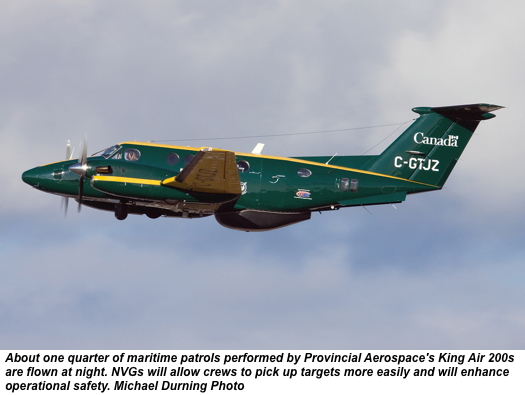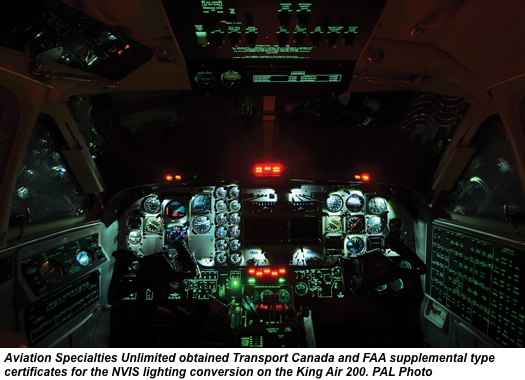Estimated reading time 4 minutes, 11 seconds.
Provincial Aerospace Ltd. of St. John’s, NL, has charted new territory with the addition of night vision imaging system (NVIS) lighting equipment to one of its Beechcraft King Air 200 maritime patrol aircraft. The work was done by Aviation Specialties Unlimited (ASU) of Boise, Idaho, with supplemental type certificate (STC) approval obtained from both the U.S. Federal Aviation Administration and Transport Canada. The milestone adds another fixed wing STC to ASU’s repertoire; it is also significant in that it allows unrestricted NVG operation for both Canadian and U.S. registered aircraft, to include takeoffs and landings. This is the first such approval for Canadian-registered King Air 200 aircraft.
Provincial Aerospace has a fleet of five King Air 200 patrol aircraft that perform maritime surveillance for various federal government departments, in search of illegal fishing, immigration, or polluters. Together, the five aircraft fly about 8,000 hours each year. Roughly one quarter of all patrols are performed at night.
Brendan Power, senior director of aerospace services at Provincial Aerospace, told Canadian Skies that only one aircraft is being equipped with the NVIS lighting equipment for the time being.
“The most capability enhancement will obviously be nighttime flying and patrols,” said Power. “When flying at night and picking up targets, the crew will be safer. If it enhances our performance as much as we hope it will, we’ll make a decision about adding the equipment to the other aircraft.”
ASU will train Provincial Aerospace staff in Canada, with pilots undergoing about five hours of training and maintenance technicians a one-day course. Power said the company’s senior pilots will be trained first, with the exact number yet to be determined. ASU will also train a check pilot at Provincial Aerospace, who can recertify aircrew for NVG operations if currency lapses (in cases where they have not flown using NVGs in 30 days).
“We want to make sure everybody understands the role, and the responsibility, and the capability of the aircraft out of the dock,” said Power. “When we’re sure of all that, we’ll see where it goes from there.”
He added that the certification process was exceptionally smooth. “The FAA and Transport Canada were here at the same time; they did all the testing. We had a team here; whatever they needed they had. When everybody was done, it took the FAA five to seven days to certify; and then TC turned theirs around in three days. It worked out very well.”
ASU was also pleased with the process. “Our ability to work in conjunction with Transport Canada and FAA officials on fixed wing aircraft paves the way for our customers in both Canada and the United States to obtain NVIS modifications on their fixed wing aircraft to increase safety,” said ASU quality assurance manager Kip McDermott.
The two companies previously worked together a couple of years ago on another project, and Power said the relationship evolved from there. “ASU was really good to work with; we have the same kind of ‘get it done’ attitude. When this came up, we said, ‘let’s do it.’”
In addition to the King Air 200, ASU also holds fixed wing STCs for NVGs on the Cessna 208 Caravan, CASA C212, and DHC-6 Twin Otter.



